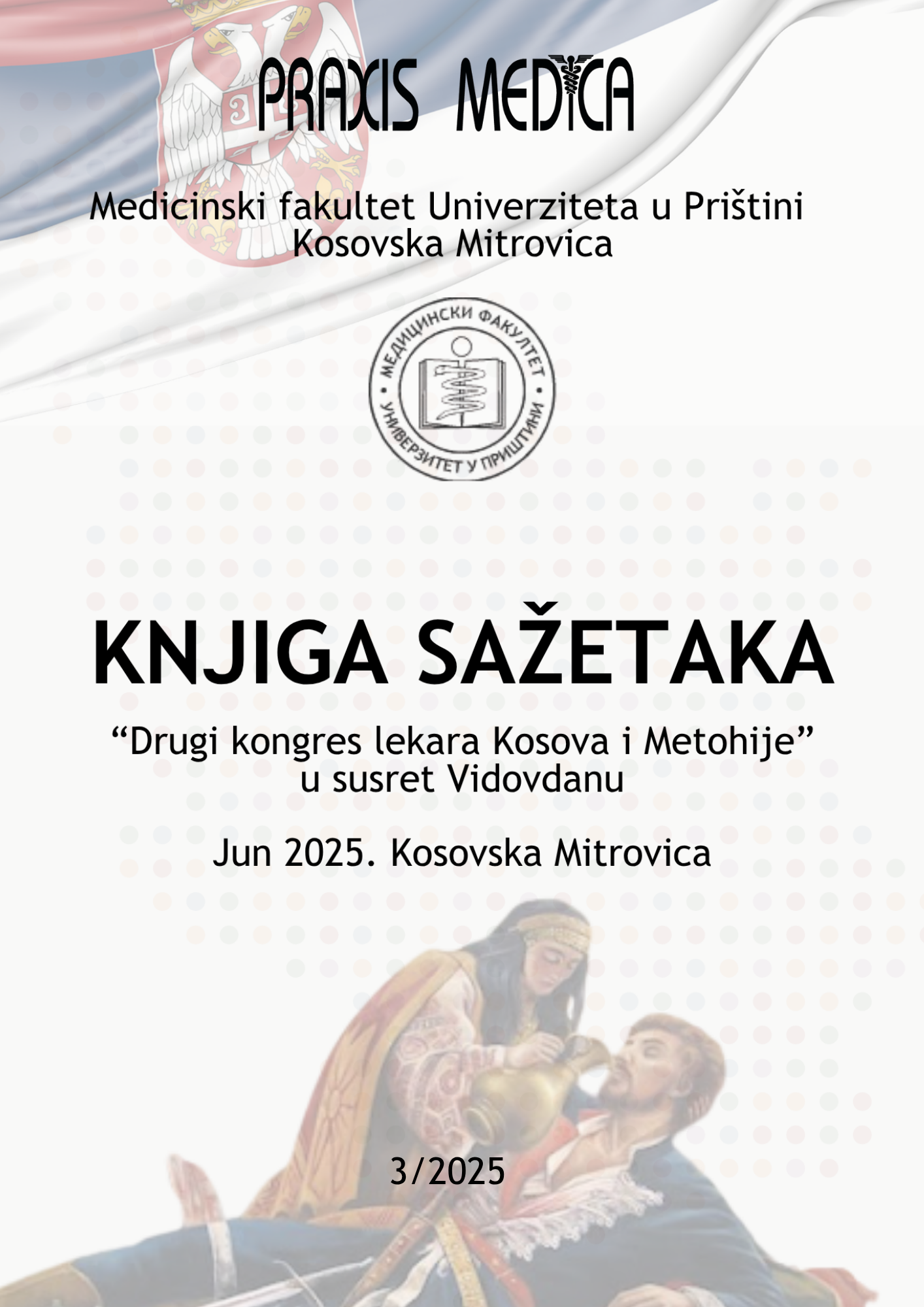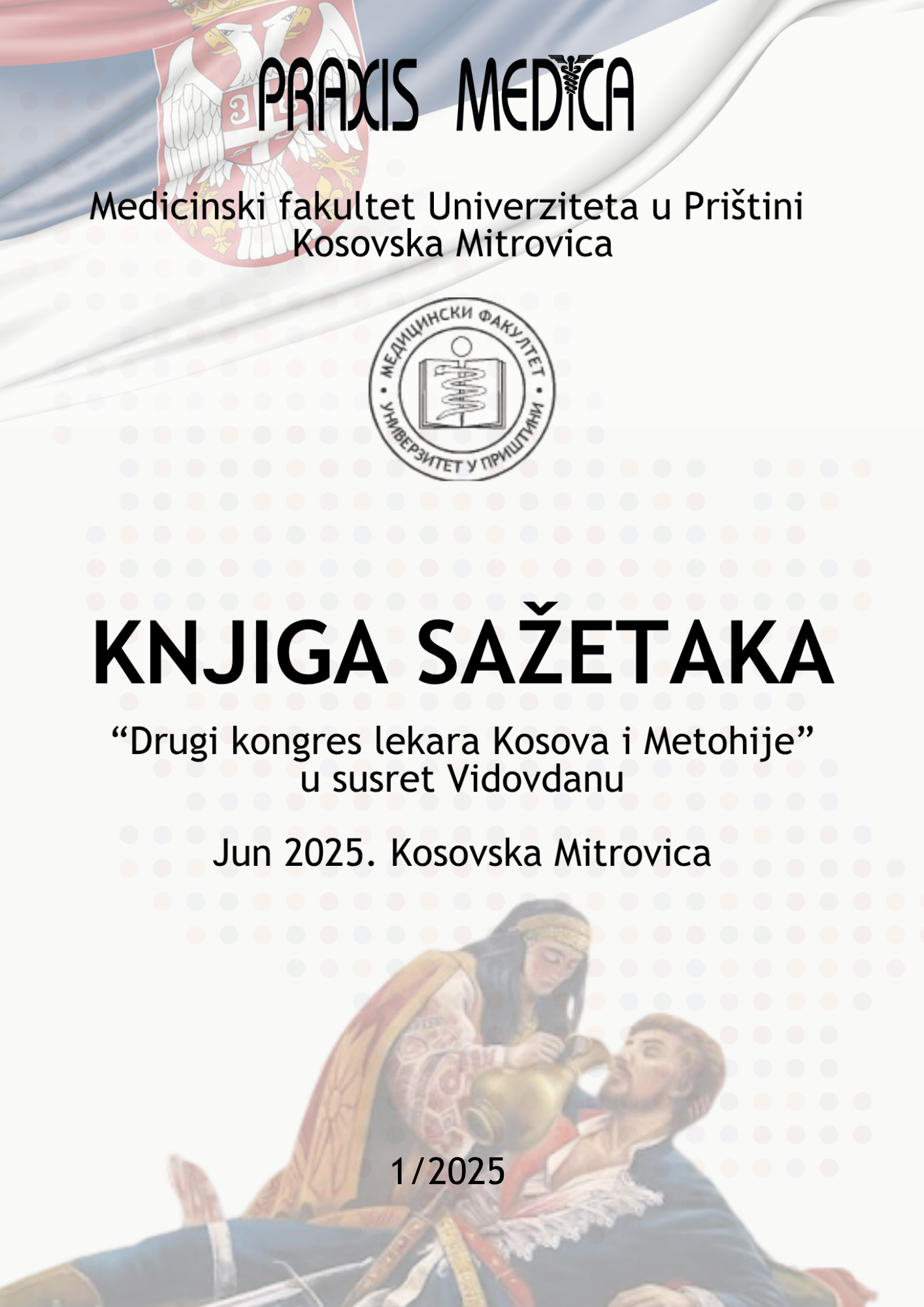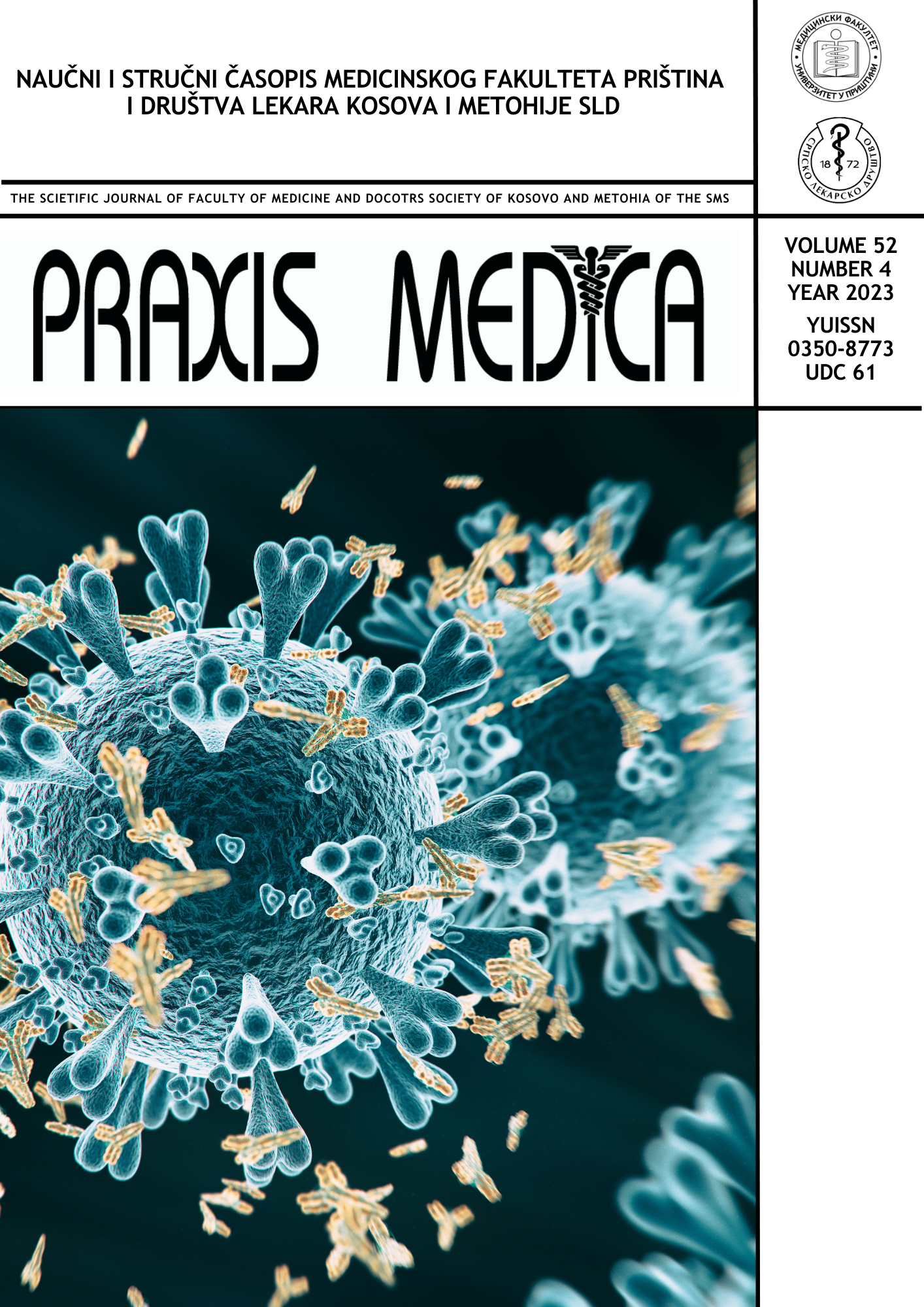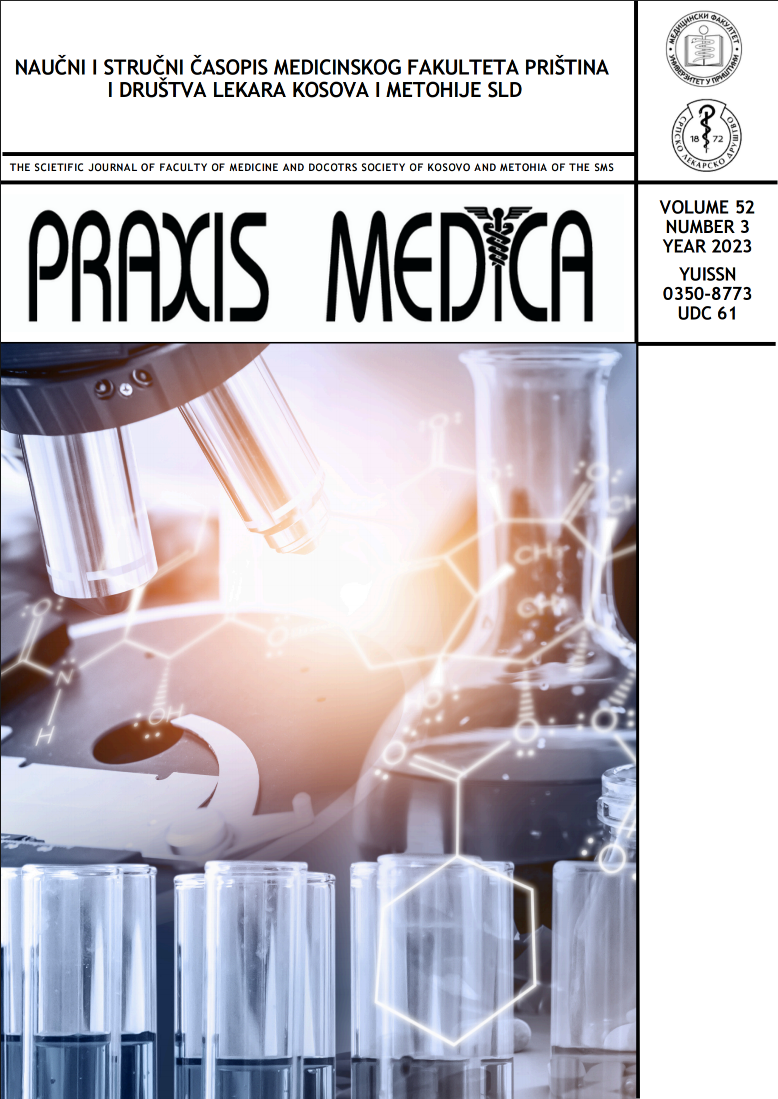Current issue

Volume 53, Issue 4, 2025
Online ISSN: 2560-3310
ISSN: 0350-8773
Volume 53 , Issue 4, (2025)
Published: 30.06.2025.
Open Access
All issues
Contents
01.01.2017.
Professional paper
The determinants of initial bleeding and rebleeding of duodenal peptic ulcers
Acute bleeding of the upper gastrointestinal tract is an urgent condition with high morbidity, and a significant mortality despite advanced diagnostics and therapy. The goal is to investigate the determinants of the severity of duodenal peptic ulcer bleeding. The research included 304 patients hospitalized for acute bleeding from the upper part of gastrointestinal tract in a five year period. They had been treated in the Clinical Hospital Center Bežanijska Kosa in Belgrade. The diagnosis was made via gastroduodenoscopy. Out of the 304 patients, 197 (65%) suffered from bleeding peptic ulcer. 144 (73,1%) patients suffered from bleeding duodenal ulcer, most frequently with bulbar localization 124/86 (12%); 78 (62,9%) with a duodenal bulb back wall lesion. 48 (35,1%) of the bleeding duodenal ulcers were in the Forrest Ib stage, in 68 (47,2%) patients the size of the ulcer lesion was between 1,1-2,0 cm. A statistically positive correlation was determined between the duodenal ulcer lesions and the intensity of the bleeding (p<0,005). With 68/79/86,1% patients treated endoscopically, haemostasis was successful, whereas in 13/19,1%, rebleeding was localized in 11/84,6% in the duodenum bulb bask wall.
Bratislav Lazic, Slavisa Matejic, Simon Nikolic, Jasna Gacic, Dragan Gacic, Petar Jovanovic, Bozidar Odalovic
01.12.2016.
Professional paper
Randomization techniques in protocols for cluster randomized trials
Introduction: Planning cluster randomized studies requires special attention due to their specific design. To achieve balance on a cluster level as well as on individual level, it is necessary to apply randomization techniques which involve restricted randomization. Objective: Determine randomization techniques as well as their frequency in protocols for cluster randomized trials. Materials and method: Searching the MEDLINE bibliographic database, there were 1020 bibliographic units, the analysis included only the protocols for cluster randomized trials, which was a total of 169 trials. Data on randomization techniques, units of randomization and publication years of protocols were extracted. Results: The randomization technique with most frequency was stratification (35.9%). After stratification the most frequent was simple randomization (13.5%), followed by a combination of block and stratification (10%), block randomization (9.4%) and matching (9.4%). The most frequent units of randomization were health facilities (52%). The number of published protocols statistically increases during time (p<0.01). Conclusion: The most frequent randomization technique used by researchers is restricted randomization
Mirjana Kostic, Dejana Stanisavljevic, Aleksandra Ilic, Zoran Bukumiric, Marija Jovanovic, Goran Trajkovic
01.01.2017.
Professional paper
Specificity and sensitivity of preoperative total serum prostate specific antigen in diagnosis most common histopathological change of prostate
Determination of preoperative prostate-specific antigen (PSA) value is primary procedure in diagnosis of different pathological prostate changes (prostate cancer-PC, prostatic intraepithelial neoplasia-PIN and benign prostatic hyperplasia-BPH), followed by digital rectal examination and prostate biopsy as gold standard. Disadvantage of high sensitivity and low specificity of PSA testing in diagnosis of PC is a problem in clinical practice. Aim was to determine the diagnostic performance of PSA in diagnosis of PC, PIN and BPH. The study included 100 patients divided into three groups: 70 with PC, 20 with a PIN and 10 with BPH. Patients with PIN and BPH were control group. Preoperative PSA values were determined by Tandem-R, The patients were divided into subgroups by baseline PSA level as follows: 4-10, 11-20, 21-30, 31-40 and> 40. The definitive histopathological diagnosis was made on routine hematoxylineosin slides. The area under the receiver operating characteristic curve (ROC), sensitivity-SE and specificity-SP of each PSA level were evaluated for PC. Preoperative serum PSA levels in patients with PC (median-35.82 ng/ml, min-6 ng/ml, max-960.40 ng/ml) were significantly higher than with PIN (median-9.15 ng/ml, min-3.16 ng/ml, max-27.61 ng/ml) and BPH (median-8.68 ng/ml, min0.80 ng/ml, max-31.20 ng/ml). The best diagnostic characteristics of the PSA are on limit value 10 ng/ml (AUC=0.781, SE=92.9%; SP=63.3%; p<0,0001). PSA is of great help in diagnosis of advanced and initial form of PC. The chance of PC diagnosis was greater than that for other pathological changes when PSA level was higher than 10 ng/ml.
Milica Mijovic, Danica Vukicevic, Branislav Djerkovic, Sladjana Savic, Leonida Vitkovic, V. Nedeljkovic
01.01.2017.
Professional paper
Correction: Antioxidant activity of lichen cetraria aculeata (2016, vol. 45, no. 3-4)
U Urednistvo
01.12.2016.
Professional paper
Systematic review of factor validity of psychiatric scales in longitudinal studies
Validity shows the degree of concurrence between the results received by an actual measuring and that of what an instrument is supposed to measure. There are three main types of validity: content validity, criterion-related validity and construct validity. Factor validity is a special approach to constructive validity, tested by statistical analysis called factor analysis. Hamilton rating scale for depression and Montgomery-Asberg depression scale are the most widely used psychiatric instruments. The aim was to carry out a systematic review of the literature on factor structure of psychiatric scales reported in different times during longitudinal studies. The units of analysis were published papers obtained by searching the two bibliographic databases: MEDLINE and PsycINFO. Factor validity of the HAMD scale was reported in 6 (0.09%) of 6590 studies which used this scale, whereas the factor validity of the MADRS scale was reported in 4 (0.2%) of 2051 studies which used the MADRS scale. The difference between the first and the last measuring in relation to values was not statistically significant: median of the number of extracted factors of the HAMD scale (p=0.371), median of total explained factor variance of the HAMD scale (p=0.250), median of variance explained by the first factor of the HAMD scale (p=0.125). Factor validity of the MADRS scale in repeated measuring also did not have statistically significant difference for the following values: median of the number of extracted factors of the MADRS scale (p=0.174), median of variance explained by the first factor of the MADRS scale (p=0.125). Coefficients of concurrent validity of the HAMD i MADRS depression scales show the trend of increase in longitudinal studies and their values are for about a third higher at the end of studies than in their beginning. Low frequency of reporting the data about reliability and validity of applied rating scales is the main problem in using the meta-analytical methods effectively to study changes in adequacy of measures in longitudinal studies.
Aleksandra Ilic, Zoran Bukumiric, Mirjana Kostic, Marija Jovanovic, Goran Trajkovic
01.12.2016.
Professional paper
Arthritis follows an acute urogenital or intestinal: Reiters disease
Arthritis following dyzentery or urethritis was mentioned before our era and later by many others. In 1818 Benjamin Brodie described 5 patients with typical „ Reiters disease”: urethritis, conjunctivitis, arthritis. Many diagnostic criteria for Reiters disease / reactive arthritis have been proposed for practical purpose the most acceeptable is the folowing one: posturethritic or postenterocolitic arthritis is Reiters disease / reactive arthritis. The findings of Chlamydiy from the synovia or in the synovial fluid of itients with RD suggest that arthritis may be of infective but not of reactive origin.
Zlatica Petkovic-Mirkovic, Jana Mirkovic, S. Milinic, Tatjana Novakovic, Bogdan Dejanovic, Gordana Nikolic, T. Fajertag, G. Jankovic
01.12.2016.
Professional paper
Cognitive functions of patients with epilepsy treated by topiramate
Topiramate is a newer drug with a strong antiepileptic potential, but also with adverse effects, especially on cognitive functions. This review deals with the study covering the impact of topiramate on cognition in patients with epilepsy. The most common side effects are included somnolence, psychomotor slowing, difficulty in memory, concentration and attention disorder and problems with speaking. Most studies have shown that a high initial dose, rapid titration and application in polytherapy increase the risk of cognitive impairment after-introduction of topiramate. In addition, depression and early onset of the disease can also contribute to cognitive adverse effects, even at low doses of the drug. Although topiramate indisputably linked to the risk of interference cognitive impairments, some studies suggest their reversibility. This, together with high efficiency antiepileptic obliges researchers to continue searching for the risk factors and mechanisms of cognitive side effects in order to define the profile of patients who would be of maximum benefit of the drug in controlling seizures with absent or acceptable side effects.
Nenad Milosevic, Boban Bisevac, Snezana Danic-Filipovic, Mirjana Dejanovic, Marko Miric, Jovana Milosevic
01.12.2016.
Professional paper
The problems associated with the treatment of chronic hyperuricaemia in Serbia
Gout is a direct consequence of chronic hyperuricaemia, who 's prevalence is following sedentary lifestyle and improper diet dominated by foods rich in purines and non-alcoholic and alcoholic beverages with sweeteners. Since gout is associated with other serious comorbidities is essential that the treatment of this disease would be adequate. The results of numerous studies indicate that the worldwide therapy of gout is insufficient in most patients. There is no doubt that this assessment is true for the treatment of gout in the Republic of Serbia, and the reasons for such an assessment are numerous. The most important reason is related to the choice of drugs, because in Serbia they are only available xanthine oxidase inhibitors, which reduce the formation of uric acid, while drugs that increase the excretion of uric acid- Uricosuric drugs are not registered. Beside uricosurics, in Serbia is not registered neither colhicine, a drug that has a very important role in the prevention of adverse effects of antihyperuricaemia drugs in the first few weeks of treatment.
Milos Milosavljevic, Milica Milosavljevic
01.12.2016.
Professional paper
Impact of ocular comorbidities on visual function and quality of life in cataract and pseudophakic patients
Introduction: Age-related cataract (senile cataract) is one of the leading causes of preventable blindness in the world. Objective: To determine whether other ocular comorbidities (glaucoma, age related macular degeneration, diabetic retinopathy) affect visual function and quality of life in cataract and pseudophakic patients, and, if possible, to determine which disease has a significant effect. Methods: In this study 202 patients were examinated, regarding of the status of cataract on the second, following eye; the patients were divided into two groups: cataract and pseudophakia. Results: Patients with myopia and capsular glaucoma had significant improvement in average visual acuity (0.87 vs. 0.65) after surgery compared to preoperative results (0.38vs.0.24) (p<0.01). Also, patients with age related macular degeneration and non-proliferative diabetic retinopathy with an average preoperative visual acuity (0.05 vs. 0.05) after surgery have a significant improvement in average visual acuity (0.2 vs.0.2) (p<0.01). Patients with primary open-angle glaucoma have significant improvement in average postoperative visual acuity (0.28) compared to the preoperative results (0.05) (p<0.01), while patients with primary angle closure glaucoma had improvement in postoperative average visual acuity (0.1) compared to the preoperative results (0.05) (p<0.1). Conclusion: Significant improvements in postoperative average visual acuity compared to preoperative results reduce difficulties in vision-related activities thus providing higher quality of life.
Dubravka Vuksa, Divna Stamenkovic, Olivera Djokic, Jana Mirkovic
01.12.2016.
Professional paper
Comparison of clinical, biochemical and morphological parameters in patients with chronic hepatitis B
Introduction: Hepatitis B virus is primarily hepatotropic, causing chronic hepatitis B in 5-10% of patients. Chronic hepatitis B (CHB) infection is a dynamic process, which may have five phases: immunotolerant, immunoactive, latency phase, reactive and HBsAg negative phase. Aim: Analyze clinical and biochemical parameters in relation to morphological condition of the liver. Material and Methods: The study enrolled 35 patients diagnosed with CHB, 24 males and 11 females, aged between 12 and 62 years, in the period 2015-2016. The diagnosis was based on serological, biochemical results, and liver biopsy. In patients in an ELISA assay demonstrated the presence of HBsAg in serum. Results: The study shows that middle-aged male patients are more prone to chronic hepatitis B infection. Most patients have one or two symptoms.Fatigue and right subcostal pain are most commonly present in the groups with fibrosis in second- and third-degree,and hepatomegaly in the group with fibrosis in first-degree. Splenomegaly is present only in groups with fibrosis in third and fourth degree. Elevated average aminotransaminase levels reflected the degree of fibrosis. Significant statistical difference in aminitransaminase levels was confirmed between the group of patients with third- and forth-degree and patients without fibrosis. Conclusion: The increase in ALT levels reflect the degree of fibrosis and cirrhosis of the occurrence. ALT levels may be a predictor of the process of the fibrogenesis, as well as to indicate the degree of fibrosis in HHB infection. Due to frequent discrepancies between clinical manifestations and results of laboratory tests, liver biopsy has been considered “gold standard” for establishing the diagnosis, staging chronic hepatitis B, making therapeutic decisions, monitoring the course of the disease, and assessing prognosis.
Vanja Nickovic, Andrijana Odalovic, Jelena Aritonovic, Boban Stolic











